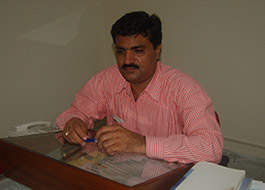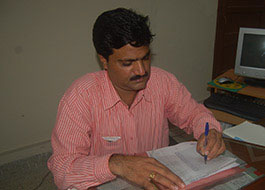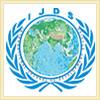Dr. R. S. Meena
Faculty of Commerce,
Banaras Hindu University, Varanasi
rsmeenabhu@gmail.com Tel.: (+91) - 542 - 2575724 Mobile: (+91) - 9415813184 International Journal of Development Studies Call for Papers Edited Books

Edited Books
Correspondence Details
Call For Papaers Edited Books
 -
- Respected Professors and friends,
You will happy (those who have contributed papers) to know that finally one International Journal of Development Studies (IJDS) Multidisciplinary Global Journal ISSN 0975-5799 and Two books Information Technology and Business Communication, Business Environment edited by me have been published by the publisher i.e. B.R. Publications, New Delhi/ Kalyani Publishers New Delhi.
Now I am working for editing some other books covering current important topics as detailed below. I, therefore, invite the learned research papers/Articles/Case Studies on the following themes for edited book(s).
1. Role of Human Resource Management in the Current Business Scenario
Challenges of Globalization and the Role of Human Resources Management/Challenges of HRM to the Corporate Sector in the Era of Global Recession/Personnel Management concepts/practices/Challenges faced by a HR Managers/It focuses on the high-performance organization/ building better/faster/ more competitive organizations through HR/personnel-related responsibilities/the strategic role of human resources/recruitment/placement/training/development/performance appraisal/compensation/motivation/labor relations/employee security/international HRM for human resource personnel, especially managers/companies face are the global challenge, the challenge of meeting stakeholder needs, the high performance work practices challenge, and the challenge of competing in the new economy/management majors of HRM professionals/conceptual model of the placing HRM in the overall context of business management./the current role of HRM/international HRM/Internet/emerging legal concerns/social responsibility/performance appraisal of HRM/ Efficient and effective management of the "Human Capital Pool" (HCP)/HR Outsourcing/Mergers and Acquisitions-the HR Dimension/HRM is playing a key role in Enterprise Resource Planning(ERP)/The HR management module/Role of IT and knowledge and opportunities for empowerment/Using Information Technology for Effective human resource management and other HRM related research article. Case Studies and other important topics and issues may be thought off by the paper contributors.
2. Agricultural Marketing and Rural Management: Problems and Challenges
Agricultural Marketing Approaches/Problems/Challenges of Agricultural Marketing/Agricultural Marketing Cost/Agricultural Marketing Credit/Growth of Agricultural Marketing/Agricultural Product/Foreign Market for Agricultural Product/Agriculture Consumers/Agricultural Markets/Rural Markets/Pricing and Distribution of Agricultural products/Demand for Agricultural Product/Export promotion of Agricultural Production/Agricultural finance/Commodity Marketing/Food security and business management/Genetically modified crops and sustainable development/ sustainable agriculture/Economics of sustainable development/Environmental protection in rural areas/Indigenous communities and sustainable development/Technology transfer and sustainable development/Renewable energy and rural development/Environmental marketing/Green house for rural development/Role of PRIs in sustainable agricultural development/SHGs and sustainable agriculture/Media and sustainable agricultural development/Food surplus and rural capital formation/Empowerment of tribal and sustainable development/Corporatization of agriculture/Remote sensing in agriculture/Global warming and climatic change/Crop productivity and sustainability/Hybrid technology/Medicinal plants and herbs and sustainable development/Agro processing industries/Organic farming/Dry land farming/Precision farming/Social forestry/Agro forestry/Bio-pesticides/Vermi-compost and sustainable agricultural development/ Bio diesel/Joint forest management/ Waste land management/Watershed management/Rain water harvesting/Agritourism/ Rural tourism/Eco-tourism/Co-operatives-sugar/dairy/PACs and other Agricultural Marketing and Rural Management related research article. Case Studies and other important topics and issues may be thought off by the paper contributors.
3. Modern Banking System in India: New Trend and Prospects
Recent trend in Banking industry in India/ Banking sector reforms/Contemporary issues/World Financial Crisis's of Banks/ World economic recession and financial Markets/Indian Capital market in present economic recession/Integration of capital markets at global level/Economic value added/ Indian banking challenges ahead/Banking and rural development/The role of banks post nationalization scenario/Role of commercial banks in rural credit and development/Rural credit delivery system/Rural banking in India/Regional rural banks/Role private sector banks/Management of mutual funds/Banking and E- commerce/Information Technology/Challenges in EBanking/ E-Finance Strategies/Online/Internet Banking/Mobile Banking/Internet/Electronic Payment system/RTGS/NEFT/NECS/ECS/OPT/IVR/Online Brokerage/E-Banking Risks/Evaluation of E-Banking System/Retail Banking/Financing for sustainable rural development/Performing of banks with non performing assets/Poverty Alleviation through Micro-finance and SHGs/SGSY/NAREGA/MNAREGA and Cooperative Banking. Mergers and Acquisitions of Banks/ other Modern Banking System in India related research article. Case Studies and other important topics and issues may be thought off by the paper contributors.
4. Entrepreneurship in India: Emerging Issues and Challenges
Entrepreneurship/Retrospect and prospects/Entrepreneurship development/Growth/Problem/Emerging Trend/challenges/opportunities/agri-entrepreneurship development and management/Technology transfer to entrepreneurship development/Institutional support systems to entrepreneurship/Role of IT and knowledge management in entrepreneurship development/Rural and opportunities for empowerment/Tribal entrepreneurship/Craft technology and the entrepreneurship/Rural artisan and the entrepreneurship/Role of cooperatives entrepreneurship/Rural entrepreneurship/Cooperative enterprises and/entrepreneurship in the new wave of economic development programmes/women Entrepreneurship in India and other Entrepreneurship in India related research article. Case Studies and other important topics and issues may be thought off by the paper contributors.
Purpose: We are soliciting manuscripts from Academicians, Industry professionals, policy makers, citizens, opinion leaders, Research Scholars, media person on the economy, executors to knock their intellectual capacities for personal and professional expansion, Service providers and Management practioners with expertise.
The paper writers can follow the general guidelines as specified for the articles in the international standard journals. The book will be published by a reputed publisher from Delhi within a short period. Kindly send a hard copy of the paper(s) along-with a soft copy of the paper(s) in MS word CD at your earliest so that the book(s) may be published at an early date. Papers may also be sent through Email.
Dean/Principal/Director/Chairman/Administrator of the College/Institute,
Dear Sir/Madam,
I request you kindly to contribute your valuable paper(s) and give wide circulation of this invitation letter/forward through E-mail to all the Faculty members./research scholars of your esteemed College/Department/Institute and other related Departments i.e. Commerce/Business Administration/Agri-Business Management/Economics/Agricultural Economics/Agriculture Extension/Geography/Institute of Foreign Trade, Banking/Sociology, Law, Centre for Women Studies, Centre for Agriculture and Rural Development/Humanities/Home Science/Institutes of Cooperative Management/Information Technology and other related departments.
I shall be highly thankful to you for kind cooperation and help extended by you. Looking forward to hear from you,
Full Information about the Above Publications Visit: www.rsmeena.com/ijds
Yours sincerely
(Dr. R.S.Meena)
Instructions to Authors for Paper Submission
The contributors are requested to adhere to the following guidelines.
The Editorial Process: The selection of papers for publication is based on their originality, knowledge content and application. The book endeavors to maintain balance between purely research oriented papers and those derived mainly from the experiences of practitioners involved in different areas of management. The manuscripts will be reviewed for possible publication with the understanding that they are being submitted to once at a time and have not been published, simultaneously submitted, or already accepted for publication elsewhere. The Editors will review all submitted manuscripts initially. Manuscripts with insufficient originality will be rejected. The editors will not return the unaccepted manuscripts. Other manuscripts will be kept with reviewer(s)/Editors for review process. Within a time frame, the contributors will be informed about the editorial decision. Articles accepted would be copy edited for grammar, punctuation and print style.
About Manuscripts:
Introduction: Manuscript must be in English prepared on a standard A4 size paper setting. It must be prepared on a double space and single column with 1" margin set for top, bottom, left and right. It should be typed in 12 point, Times New Roman Font with page numbers at the bottom and centre of the every page.
Manuscript Title: The title of the paper should be in a 12 point Calibri Font. It should be bold typed, centered and fully capitalized.
Title, Author Name(s), affiliation(s), contact details & Affiliations: The author (s) full name, designation, affiliation (s), address, mobile/landline numbers, and email/alternate email address should be in 12 point Calibri Font. It must be centered underneath the title.
Abstract: Abstract should be in fully italicized text, not exceeding 300 words. The abstract must be informative and explain background, aims, methods, results and conclusion.
Keywords:Abstract must be followed by list of keywords, subject to the maximum of five. These should be arranged in alphabetic order separated by commas and full stop at the end.
Headings: All the headings and sub-headings should be in a 10 point Calibri Font. These must be bold faced, aligned left and fully capitalized. Leave a blank line before each heading.
Main Text: The main text should be in an 8 point Calibri Font, single spaced, fully justified.
Figures & Tables: These must be simple, centered & numbered, and table titles must be above the tables. Sources of data should be mentioned below the table.
Spellings: Use 'z' spelling instead of's' spellings. This means that words ending with 'ise', 'isation', etc., 'will be spelt with 'z' (e.g., 'recognize', 'organize', 'civilize'). Use British spellings in all cases rather than American spellings (hence, 'programme' not 'program', 'labour' not 'labor', and 'centre' not 'center').
Hyphenation: Please pay attention to consistency in the hyphenation of words. Do not alternate, for example, between 'psycho-social' and 'psychosocial', 'decision making' and 'decision-making'. (A distinction is, however, often made between noun and attributive adjective: for example: 'the middle class' but 'middle-class ethics'.)
Capitals: Use capitals sparingly and double-check the logical application of any distinctions you wish to make between specific and general use. Abbreviations: Include a final stop in abbreviations (words shortened by omitting the end), such as p., vol., and ed., but not in contractions (words shortened by omitting the middle), such as Mr, Dr, edn and eds. No stops are needed between capitals: e.g., IIM, EMBRASCON, AIDS. Short forms likely to be unfamiliar to some readers should be spelt out in full the first time they occur. Please avoid using 'i.e.' and 'e.g.' in the text but use them in the notes if you wish.
Notes: Notes should be numbered consecutively and presented at the end of the article on separate sheets of paper (and not at the foot of each page), typed in double space throughout, and with the heading 'Notes'. An acknowledgement or statement about the background of the article will be set as an unnumbered note before any other note. Notes should contain more than a mere reference.
Figures and Tables: Please present each figure and table on a separate sheet of paper gathering them together at the end of the article. Distinguish between figures (diagrams) and tables (statistical material) and number them in separate sequences, i.e., 'Figure 8', and 'Table 8.'
- 1. Please use short and crisp titles and headings in tables and figures. The units of measurement should be stated and the sources should be cited at the foot of the table. Notes relating to the table should be placed after the source. Lay out parallel tables in similar ways using similar wording, and check any totals or averages.
- 2. Include a mention of each figure or table in the text itself (for example 'as shown in Figure 2'), as well as indicating in the margin where the figure or table should go ('Fig. 2 near here'). Ensure that all words, proper nouns, place names, etc., in the tables and figures are spelt in exactly the same way as they are in the text.
- 3. If you have the facility to provide original figure artwork of sufficient quality to be reproduced in the journal, it will certainly be welcome. If the artworks you are providing are larger than the print area of the journal, please ensure that all details and text in the artworks are sufficiently large so that they remain legible when reduced to the actual printed size of the journal. Further, it is crucial that all text in the artworks corresponds to the text of the article in spelling and style. Please obtain permission to reproduce any figures or photographs that are not your own copyright. Similarly, permission may be required for quotations beyond the limits of 'fair dealing'.
Numbers: Write numbers in figures (rather than words) for exact measurements and series of quantities, including percentages. In more general description, numbers below 10 should be spelt out in words. Use thousands, millions, billions, and not lakhs and crores. In the text use 'per cent'; in tables the symbol '%'. Write '0.8' rather than '.8', except for levels of probability. Use lower-case Italic for p (probability) and n (number). Use fuller forms for numbers and dates-e.g., 1980-88, and pp. 200-202.
Dates: Give specific dates in the form 22 November 1980. Decades should be referred to as 'the nineties'. Spell out 'the twentieth century', etc.
Miscellaneous: Please refer to your own contribution as 'this article'. The style for cross-references to figures and tables should be 'as Figure 2 shows' or 'as Table 1 shows' and not 'as shown in the figure below' or 'as shown in the table above'.
References: The list of all references should be alphabetically arranged. The author (s) should mention only the actually utilized references in the preparation of manuscript and they are supposed to Harvard Style of Referencing. The list of all references should be alphabetically arranged. The author (s) should mention only the actually utilized references in the preparation of manuscript and they are supposed to follow the references as per following:
All references must be placed at the end of the paper, following the endnotes. The list should state only those references, which are either cited in the text or the notes. More than one publication of the same author in the same year must be listed chronologically with the older item first. Use small (lower case) letters to denote them.
Example: Meena (2002a), Meena (2002b). Other references should follow the following formats
- Books: Meena, R.C. (2004), Principles of Economic Development, Pragati Prakashan, Meerut.
- Business Magazine:"Three Letter Acronyms That Mean Business", (April 2005) Benef of Business- IT Magazine, MFY Group Vol-1 Issue 4
- News Paper: Times of India, New Delhi Edition, Page-7, Date 10/06/09
- Chapters in Edited Books: Gupta, M. (2001), 'Development of Financial Services'. In R. Prasad (Ed.) Framework of Financial Services (pp. 45-70). New York: Free press
- Journals & Periodicals: Shehra, Priyanshu & Sharma TP (2005), 'Stock Market and Indian Economy', Indian Management Studies Journal, Vol.8, No.4, pp.08-24.
- Reports: National Stock Exchange (2001), Report of NSEI Committee on Deli sting of Shares-Chakarvarty Committee.
Electronic Information
- WEBSITES: Pearson, R. (2000) Online Development study guide, http:\\www.dev.ac.usa\schools\skills\refern.htm, Date accessed 10/07/2001.
- CD ROMS: Lewis, P. (1999) A Guide to Financial Literature, CD-ROM, USA: Sunshine Publishers.
- Authors would have to certify that the material is unpublished, as well as original. The Organizing Committee will have the copyright over the papers submitted to us.
- An expert committee will screen the paper on the parameters of research content, originality and concept clarity.
- The editorial board reserves the right to accept or reject any paper without assigning any reason.
- The discretion of the editorial board will be final regarding the inclusion of the paper in the book.
- All works cited in the text (including sources for tables and figures) should be listed alphabetically.
- Use (ed.) for one editor, and (ed.s) for multiple editors.
- When listing two or more works by one author, use XXXX (YYYY,YYYY), such as after Kohl (1997, 2001) etc, in chronologically ascending order...
- Indicate (opening and closing) page numbers for articles in journals and for chapters in books.
- Note that italics are used only for titles of books and names of journals. Double quotation marks are used for titles of journal articles, book chapters, dissertations, reports, working papers, unpublished material, etc.
- For titles in a language other than English, provide an English translation in parentheses.
- Use endnotes rather than footnotes.
- The location of endnotes within the text should be indicated by superscript numbers.
- For sources which have insufficient details to be included in the Reference, use endnotes (such as interviews, some media sources,
All Correspondence will be done through the rsmeenabhu@gmail.com only.
Best Regards
(Dr. R.S.Meena)
All Correspondence Should be Address:
Contributions send a hard copy of the paper(s) along-with a soft copy of the paper(s) in MS word CD and through e-mail should reach
The Editor,
Name : Dr. R. S. Meena (Ram Swaroop Meena)
Address : New F-1, Hyderabad Colony, Banaras Hindu University, Varanasi-22100 (U.P.), (India)
Mobile : 09415813184, (O) +91-0542-6701307, (R) +91-0542-2575724
E-Mail : rsmeenabhu@gmail.com, ijdsindia@gmail.com
Note: Papers may please be sent as early as possible.
Full Information about the Above Publications and guideline is also available at Visit: www.rsmeena.com/ijds